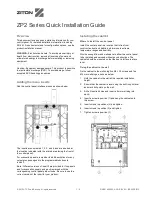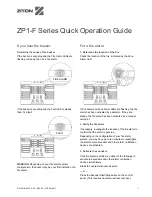
EQUIPMENT:
FIRE
CLASS
PRECEPT EN
PUBLICATION:
FIRECLASS PREC EN INST
ISSUE No. & DATE:
3 13/09/18
PAGE 13 of 30
11.
Installation
The control panel must be installed by suitably
qualified engineers familiar with the installation of
fire
detection
systems.
In
addition,
it
is
recommended to refer to the following information:
Current edition of the IEE wiring regulations.
Current edition of BS5839-1 or the installation
standards for the relevant country.
Any specific site requirements.
Any field device installation instructions.
Any data sheet provided for the installation of
Intrinsically Safe devices.
Notes:
The rating plate, containing essential electrical
information is located inside the panel on the inside
face of the door.
The mains supply cable should be a minimum of
1mm
2
copper protected by a 5A fuse.
An appropriate lockable double pole disconnect
device shall be provided as part of the building
installation. This device must have a minimum
contact gap of 3mm.
11.1
Electrical Safety
WARNING: Read this section completely before
commencing installation.
Prior to commencing installation of the
control panel, ensure that adequate
precautions are taken to prevent
damage to the sensitive electronic
components on the display board and the control
board due to electrostatic discharge. You should
discharge any static electricity you may have
accumulated by touching a convenient earthed
object such as an unpainted copper radiator pipe.
You should repeat the process at regular intervals
during the installation process, especially if you are
required to walk over carpets.
The panel must be located in a clean, dry
position, which is not subject to shock or
vibration and at least 2 metres away from pager
systems or any other radio transmitting
equipment. The operating temperature range is
0ºC to 40ºC; maximum humidity is 95%.
IMPORTANT NOTES ON BATTERIES:
DANGER: Batteries are electrically Live at
all times, take great care never to short
circuit the battery terminals.
WARNING: Batteries are often heavy; take
great care when lifting and transporting
batteries. For weights above 24 kilos,
lifting aids should be used.
DANGER:
Do NOT attempt to remove the
battery lid or tamper with the internal
workings of the battery. Electrolyte is a
highly corrosive substance, and presents significant
danger to you and to anything else it touches. In
case of accidental skin or eye contact, flush the
affected area with plenty of clean, fresh water and
seek immediate medical attention.
Valve Regulated Lead Acid (VRLA) batteries are
“low maintenance”, requiring no electrolyte top-
up or measurement of specific gravity.
WARNING:
Only clean the battery case
with a cloth that has been soaked or
dampened with distilled water. Do not use organic
solvents (such as petrol, paint thinner, benzene or
mineral spirits) or other materials that can
substantially weaken the case. Do not use a dry
cloth as this will generate static electricity, which in
turn may lead to an explosion.
WARNING:
Avoid operating temperatures
outside
the
range
of
-15
C/5
F
to
+50°C/122°F for float/standby applications.
The recommended normal operating temperature is
20°C.
HIGH TEMPERATURE will reduce battery service
life. In extreme cases this can cause Thermal
Runaway, resulting in high oxygen/hydrogen gas
production and battery swelling. Batteries are
irrecoverable from this condition and should be
replaced.
LOW TEMPERATURE will prolong battery life but
reduce output capacity.
DANGER:
Do not incinerate batteries. If
placed in a fire, the batteries may
rupture, with the potential to release
hazardous gases and electrolyte. VRLA
batteries contain substances harmful to
the environment.
Exhausted batteries must be recycled.
Return them to the battery manufacturer
or take them to your Council waste disposal site for
appropriate disposal.
ELECTRICAL SAFETY:
The volt-free relay contacts provided within the
panel must not be used to directly switch any
voltage that exceeds 50VAC or 75VDC. (Please
also refer to relay rating data).
This equipment requires a 230VAC supply. All
installation work should be carried out in
accordance with the recommendations of
BS5839 Part 1 and the current edition of the IEE
regulations by suitably qualified and trained
personnel.
THIS PANEL MUST BE EARTHED







































